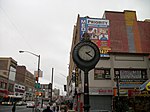Store Front Museum

The Store Front Museum was a community museum in Queens, New York that served as a cultural center and exhibition space for the black community of the borough. Established in 1971 by artist Tom Lloyd, it was originally located on Liberty Avenue, in a former retail tire dealer building. Lloyd was an artist that had made numerous showings around the country before coming to Queens. The museum was established in February 1971 and was devoted to the promotion and dissemination of African-American culture. Lloyd chose the name because "it implies community." The gallery was used for several exhibits, concert plays, karate classes, dance instructions, and festivals over the years. Lloyd acquired many of the museum’s materials from donations.
Excerpt from the Wikipedia article Store Front Museum (License: CC BY-SA 3.0, Authors, Images).Store Front Museum
Guy R. Brewer Boulevard, New York Queens
Geographical coordinates (GPS) Address Nearby Places Show on map
Geographical coordinates (GPS)
| Latitude | Longitude |
|---|---|
| N 40.700819 ° | E -73.795521 ° |
Address
York College the City University of New York
Guy R. Brewer Boulevard
11434 New York, Queens
New York, United States
Open on Google Maps








